From the Desk of Scot McRoberts: Making Our Organization More Inclusive and Welcoming
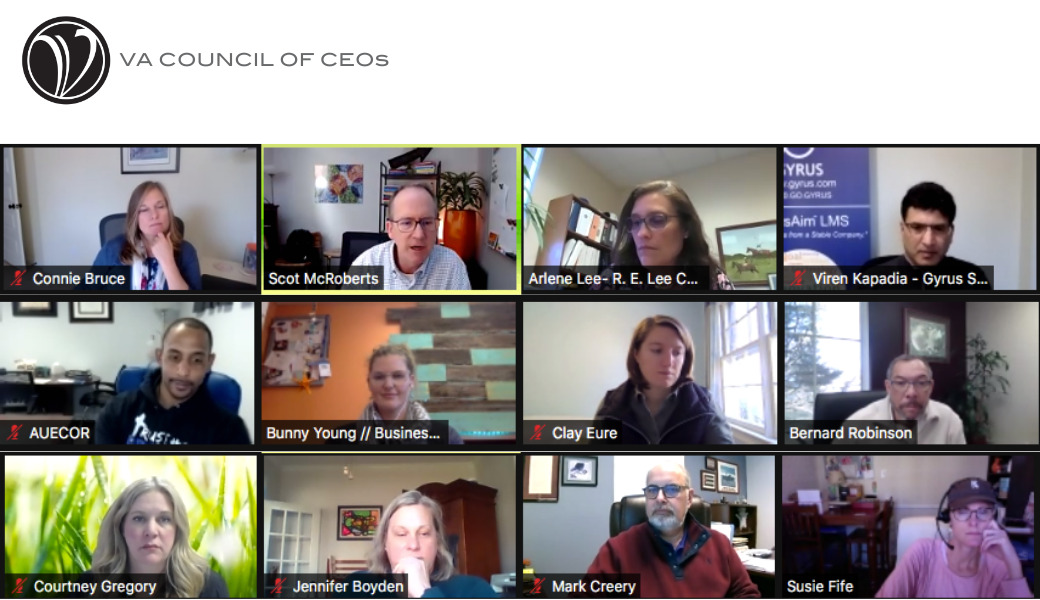
Shaw was a guy at my church. We worked together on lots of things – youth programs, Upward Basketball, service projects, and the like. He was one of those rare individuals who never met a stranger. No matter who you were – a surly teen, a blue-haired matriarch, a young woman in a wheelchair, or a wary kid from public housing – Shaw made you feel good about being there.
At Virginia Council of CEOs, we are doing some long overdue work on diversity & inclusion. Our D&I Committee held its second meeting last week, and we are getting some momentum. Last month, you made have attended Ace Callwood’s brilliant talk, “The Case Against the Case for Diversity.” In a nutshell, he says that the traditional case for D&I – better business results – is old news. Everyone knows it is true, but it doesn’t speak to the real reason that businesses should be doing this work.
When it comes down to it, I want any organization I am a part of to be like Shaw. I want VACEOs to make everyone feel good about being there, especially people who have not traditionally been involved. The business results will follow. And we don’t really need a business case to be like Shaw, do we?
About the Author
Scot McRoberts is the executive director of the VA Council of CEOs (VACEOs). One of the original co-founders, he has led the organization’s growth from 20 members in 2000 to more than 200 today. Utilizing a best practice model for the Council’s CEO roundtables and a dogged focus on its core purpose of connecting CEOs for the purpose of sharing experiences, McRoberts has developed an association that boasts 90% retention. Before coming to VACEOs, Scot was a senior executive at the Greater Richmond Chamber of Commerce, where he led business councils, small business programs, and business retention efforts.
How to Be a Better CEO in 2021

Last year at this time, I asked the members in my peer roundtable “What are your professional development plans for next year?” I was shocked when two of these CEOs said that they had done all that stuff, that they were within 5 years of exiting, and that they really didn’t see a need for it. It seemed like they had decided to just coast to the finish line of their careers.
Maybe when I am closer to retirement, I will have that attitude, but I hope not. I believe that there is unlimited potential for growth, and that if I am to be the leader my organization needs and deserves, I need to work on myself continually.
I think I am a pretty good CEO. So, what’s wrong with being the same kind of CEO again next year? Well, are my competitors sitting still or getting better? Is the pace of change in business and society slowing down? I don’t think so. If I am to lead my business to compete and thrive amidst rapid change and the unexpected (pandemic, anyone?) I must continue to learn and grow.
So I encourage you, my fellow CEOs, to make a decision about how you will grow as a leader in 2021. The options are endless. You could take a class, join a book club, retain a coach, or join a peer roundtable.
Be a better CEO in 2021. Make a decision now on how you will learn and grow.

About the Author
Scot McRoberts is the executive director of the VA Council of CEOs (VACEOs). One of the original co-founders, he has led the organization’s growth from 20 members in 2000 to more than 200 today. Utilizing a best practice model for the Council’s CEO roundtables and a dogged focus on its core purpose of connecting CEOs for the purpose of sharing experiences, McRoberts has developed an association that boasts 90% retention. Before coming to VACEOs, Scot was a senior executive at the Greater Richmond Chamber of Commerce, where he led business councils, small business programs, and business retention efforts.
Do You Need a Leadership Coach?

HINT: THE ANSWER IS MOST LIKELY – YES!
As leaders, we know the value in pushing ourselves and others to our full potential. Do the leaders in your organization expand the potential of your team? One of the most effective tools to unleashing potential of an individual or an organization is by bringing in a coach. Think about it, athletes at the pinnacle of their careers have coaches. Olympians, professional football and basketball players, even master chess players have at least one (and usually more than one) coach. Some baseball coaches focus on pitching, others on hitting but each is helping unleash the full potential of the players with whom they are working.
Why then do so many business leaders chafe at the idea of having a coach? The rules of sports and games are relatively stagnant: the batter swings and misses, it is a strike; the ball goes in the net, it is a score. However, the principles of leadership evolve, and the expectations can change overnight. One might argue that leaders need coaches far more than their athletic counterparts. With the global pandemic, political polarization, and social justice movements, 2020 stretched even the most seasoned leader. A fast pitch is still a fast pitch, but leaders are dealing with curve balls every day.
Engaging with a coach expands our self-awareness which is the critical first step in conducting any kind of behavior change. Additionally, it establishes an accountability model by which we as leaders can reflect on our progress and push ourselves further.
BUT JUST IN CASE YOU ARE STILL SKEPTICAL, HERE ARE A FEW SIGNS YOU NEED A COACH
PRODUCTIVITY:
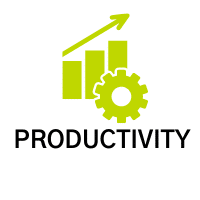
- Are you getting the most from your team?
- Have your business goals stagnated?
- Do you and employees dream back to the “good old days” when work was more fun and exciting?
Leaders need to evolve and meet the demands of their business, customers, and employees. To do that, you need highly engaged employees because engaged employees put in extra discretionary effort. It is the extra effort that can boost your sales, revenue, and production goals. Think about what your business could look like if everyone gave 110%. Ever hear that people leave managers not companies? It’s true. With that in mind, you may need to reassess your leadership style and approach to increase the productivity of your team and therefore the organization. But how do you change your style? How do you know which part of your leadership style to adapt to yield the greatest results? A coach can help you.

EMPLOYEE ENGAGEMENT:
- Have you received employee feedback that you do not know what to do with or have trouble prioritizing?
- When was the last time you assessed your employee’s level of engagement and commitment to the organization?
Most organizations only do so once a year when they conduct an employee satisfaction survey. Not enough of those organizations actually do anything with the results. This is a missed opportunity to take feedback directly from your employees, acknowledge that feedback in a meaningful way and take visible steps to address it. I often find that leaders either do not know what to do or they try some different approaches in the short term, but they do not last. Coaches can help you critically evaluate root causes and forge successful strategies to address them.
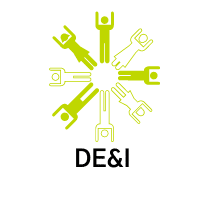 DIVERSITY, EQUITY & INCLUSION:
DIVERSITY, EQUITY & INCLUSION:
- Do you have DE&I goals but do not know how to meet them?
- Are you able to acquire diverse talent but not able to retain them?
- Do you know why?
DE&I has been an increasingly hot topic for leaders, but few know what to do beyond focusing on talent acquisition efforts and conducting an equity compensation review. How does one build an inclusive culture within an organization? How does one lead with inclusivity? Those are tough questions and answers will vary based on an individual’s leadership style and an organization’s culture. A coach can provide objective perspective, accountability, and facilitate sensitive conversations to leading to real DE&I results.
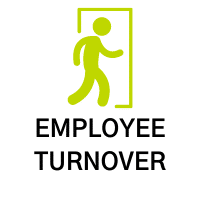
EMPLOYEE TURNOVER:
- Do you see trends in employee turnover?
- Do you have a hard time retaining female employees?
- Do you know why?
We all know that the costs of employee turnover are high and far beyond the recruitment spend. The opportunity cost and the loss of institutional knowledge can wreak havoc on an organization. Digging into why your employees are leaving and what you can do to retain them will save you great time, money, and energy.
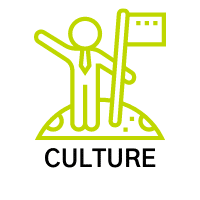
CULTURE:
- Are your leaders living your organizational values and culture individually and collectively?
- What would it take to get them there?
Yes, a coach can help you enrich your culture. Leveraging assessment tools and facilitating meaningful dialogue across your leadership team can unearth biases, misperceptions, and behaviors that are keeping your team from modeling the culture you want for your organization.
Some great business leaders have leveraged the benefits of coaching. Erick Schmidt, Steve Jobs, and Bill Gates are examples of successful leaders who have used coaches as part of their journey. Perhaps we all could be open to a coach to help us navigate the curve balls of 2021 and beyond.
To learn more about finding the right coach for you, please join us for The Coaching Continuum- Finding the Right Coach For You– February 16th 12pm EST. This free webinar will introduce you to different types of coaches and help you identify how to find the right coach for your organization.
 ABOUT THE AUTHOR
ABOUT THE AUTHOR
As Fahrenheit’s Human Capital Management Practice Area Lead, Sara Shelton brings a passion for organizational performance and creating great places to work. She enables clients to achieve their business goals by aligning and maximizing their talent, leadership, and culture. She influences with integrity and credibility, treasuring her role as consultant, advisor, and trusted confidante.
EDITOR’S NOTE: Image and content provided by Fahrenheit Advisors. Fahrenheit Advisors is a Sponsor of Virginia Council of CEOs. This post was originally posted here.
Don’t Get Caught Off Guard (Again)

Although none of us anticipated the challenges 2020 would bring, we can learn from this time and be better prepared for the next unforeseen challenge. As business leaders, we talk a lot about risk management and risk planning. But how much time have we devoted to planning for risk rather than just fighting the fires as they appear? People are our greatest asset and our highest potential for risk, and yet how often do we sit down to intentionally create a People Strategy?
As you know, the state of Virginia required all businesses to complete their Infectious Disease Preparedness and Response plans back in September. While created out of the current pandemic, the template itself is simple and resembles typical risk plans created in the past. We can use this approach to create a People Operations Risk Management Plan that can be reused in many situations and updated over time. This is a great use of current unplanned downtime.
We can use Maslow’s Hierarchy of Needs as a guide to ensure that not only do we address each needed component but that we prioritize our efforts in the most impactful way by working our way up from the bottom.
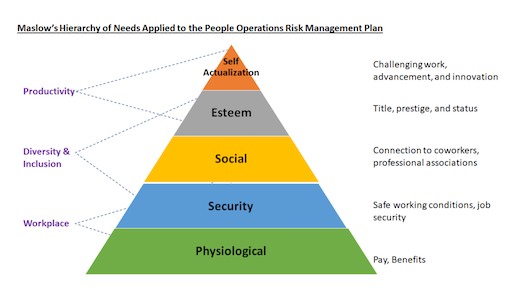
What could a People Operations Risk Management Plan look like?
- Workplace Environment: Based on your business type, what roles need to be onsite? What roles can have location flexibility? What has been the impact on productivity and culture? Could you consider flexible work options for some roles going forward? What could increased flexibility mean for your employee recruiting and retention? Note there are many more options than everyone in the office or everyone can work remotely. Think of the decision here as a dimmer switch instead of just and on/off switch.
- Productivity: How are you measuring productivity for all your employees? Did you uncover roles that did not have specific productivity measures before 2020? How will you address that gap in the future? How might you adjust your goal setting and performance processes? Being intentional here enables us not to equate physical presence with productivity for all roles and to be more transparent with employees regarding our expectations.
- Diversity & Inclusion: Do you have an employee mix with different areas of expertise and experience that can help you innovate and move your company to the next level? How are you accounting for the multi-generational workforce? How are you adapting your recruiting processes to ensure you have the right talent not just today but for the future? Diversity is a journey for individuals and for organizations. Creating a plan that moves your organization along in its journey will be unique to your organization.
There is no silver bullet to the questions above. The “right” answers will depend on the type of business you are in, your growth strategy, and the desired company culture. These factors can be weighted as part of a Risk Matrix within your People Operations Risk Management Plan. What is important now is to take time to think through your people risk and the options available to you.
We cannot control when the “new normal” will begin (and perhaps we are already in it) but we can deliberately make plans for our businesses based on what we have learned this year about our consumers, our employees, and ourselves.

About Sara Shelton
Sara, a new addition to the Fahrenheit Advisors team, leads Fahrenheit Advisor’s Human Capital Management Practice. She began her career in management consulting supporting technology, financial services, and healthcare companies through mergers, acquisitions, and other large-scale transformational initiatives. She brings a passion for organizational performance and creating great places to work. Need help creating your People Operations Risk Management Plan? Sara can be reached at sshelton@fahrenheitadvisors.com.
EDITOR’S NOTE: Image and content provided by Fahrenheit Advisors. Fahrenheit Advisors is a Sponsor of Virginia Council of CEOs.
My Man-Crush on Galloway

I consume a ton of business content. You probably do too. Occasionally I run across something so compelling that I need to share it.
Scott Galloway is a professor of marketing at NYU Stern School of Business, but before that built businesses in e-commerce and data intelligence. He is about my age and was also born in November, so I thought he would like me. I reached out to him last year to try and get him on the VACEOs stage for you. So far, no luck. He’s in high demand.
Neverthless, I am attracted to disrupters, and Galloway is a prince in that kingdom. In a smart way.
My friend Verne Harnish got Professor Galloway to speak at a recent online Scaling Up Summit, and Verne was generous enough to share @profgalloway’s 12-minute, 60-slide thrill-ride of a talk with readers of his newsletter (you should subscribe to it).
HERE’S the compelling part! Take 12 minutes to watch Scott Galloway’s talk RIGHT HERE. I guarantee it will stir something inside you – hope, imagination, greed, cursing, fear, wonder. It will be worth it. Let me know if not. Just take it easy on the expletives.
Forward!

Scot McRoberts, Executive Director, VACEOs
About the Author
Scot McRoberts is the executive director of the VA Council of CEOs (VACEOs). One of the original co-founders, he has led the organization’s growth from 20 members in 2000 to more than 200 today. Utilizing a best practice model for the Council’s CEO roundtables and a dogged focus on its core purpose of connecting CEOs for the purpose of sharing experiences, McRoberts has developed an association that boasts 90% retention. Before coming to VACEOs, Scot was a senior executive at the Greater Richmond Chamber of Commerce, where he led business councils, small business programs, and business retention efforts.


Recent Comments